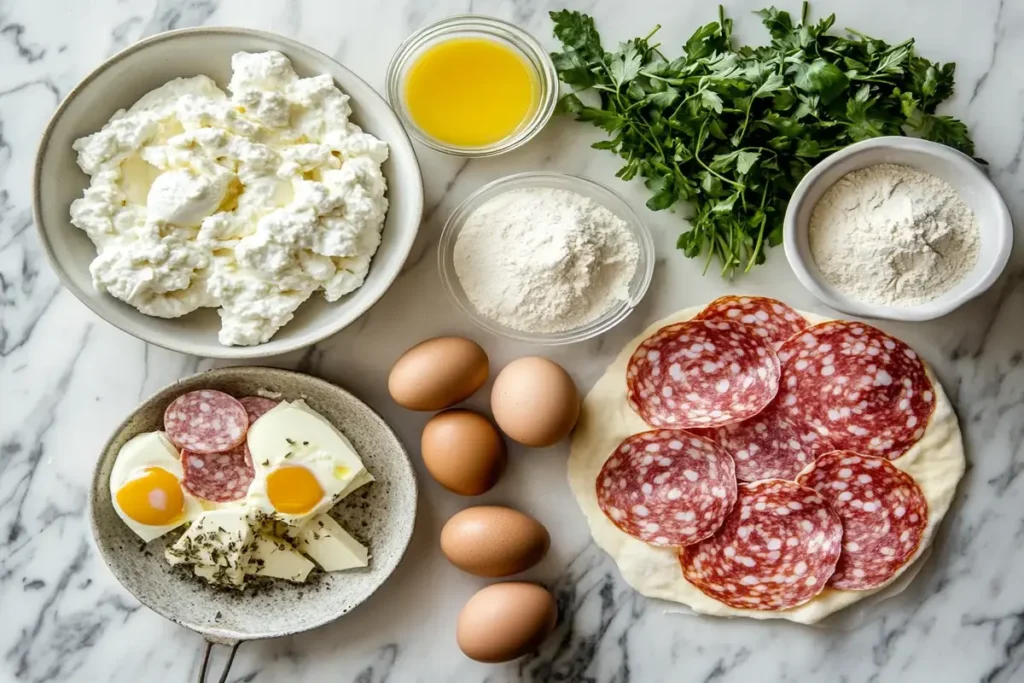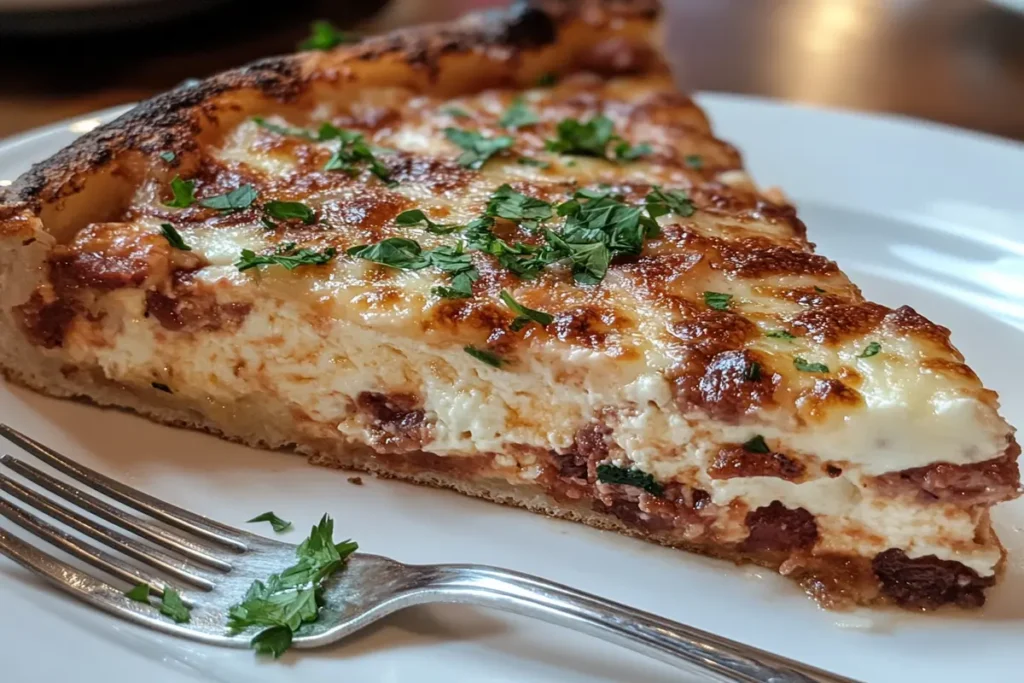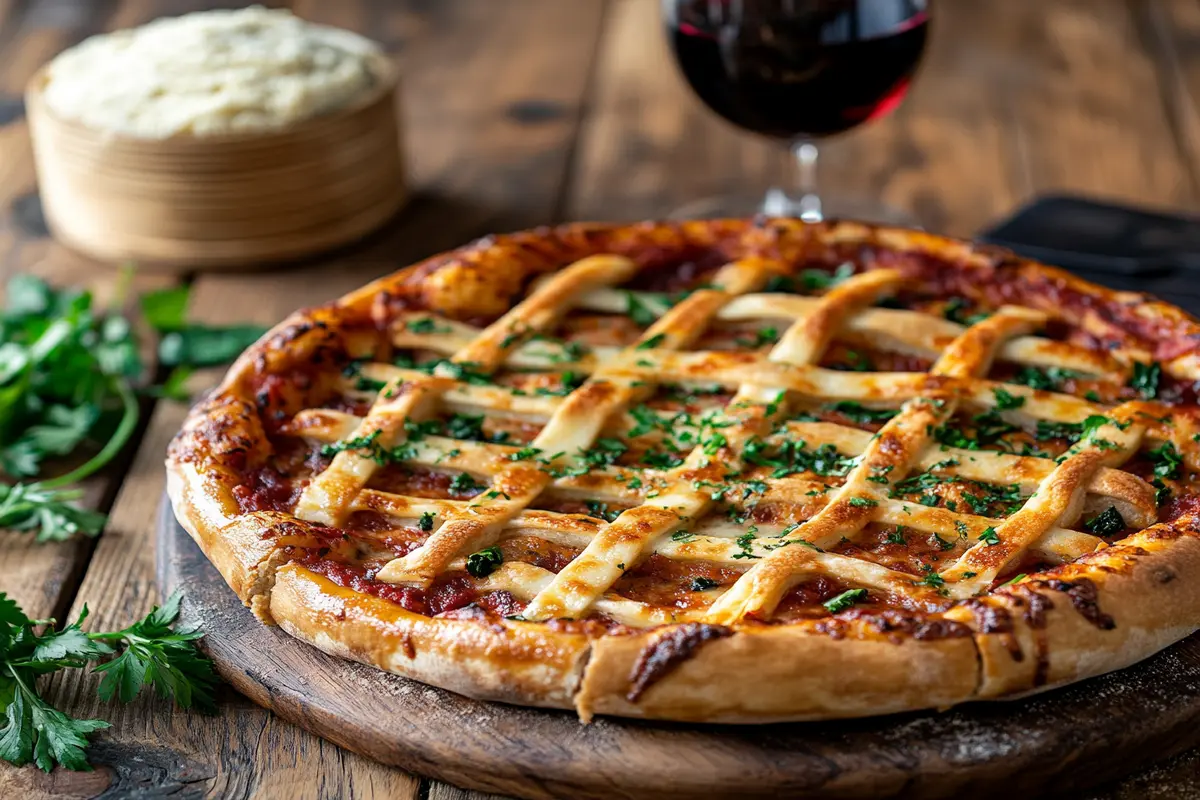Introduction
Rich, hearty, and steeped in tradition, pizza rustica recipe is the ultimate celebration of Italian Easter cuisine. Known as a savory pie, this dish combines layers of creamy cheeses, flavorful cured meats, and flaky crust to create a meal that’s as satisfying as it is symbolic. Often referred to as pizzagaina in southern Italy, pizza rustica holds a special place in the hearts of those who cherish the art of cooking and the joy of sharing food with loved ones. In this guide, we’ll explore its history, break down the key ingredients, and take you step-by-step through crafting this timeless dish.
The Origins and Significance of Pizza Rustica
The Cultural Roots of Pizza Rustica
Pizza rustica traces its origins back to southern Italy, where it was crafted to celebrate the end of Lent. After weeks of fasting and restraint, families would come together to indulge in this savory pie, a symbol of abundance and festivity. The name itself, rustica, hints at its rustic, homemade appeal—a dish meant to bring people together over hearty, comforting flavors.
While the recipe varies across regions, the concept remains consistent: a rich filling encased in a tender crust. From bustling kitchens in Naples to quaint villages in Calabria, pizza rustica embodies the spirit of traditional Italian cooking, where simple ingredients shine through thoughtful preparation.
The Symbolism Behind Easter and Pizza Rustica
For many Italians, pizza rustica recipe isn’t just food—it’s a symbol of celebration and togetherness. The dish often appears on Easter tables, representing the joyous conclusion of fasting. The combination of eggs, cheese, and meat reflects prosperity and renewal, making it a fitting choice for such a meaningful holiday.
Beyond its festive roots, pizza rustica has become a year-round favorite, cherished for its ability to bring family and friends together. Whether served warm or at room temperature, this savory pie invites everyone to savor the comforting flavors of Italian heritage.
Key Ingredients for the Perfect Pizza Rustica
Cheese Selection: Ricotta, Pecorino, and Beyond

The foundation of a great pizza rustica recipe lies in its cheeses. Ricotta serves as the creamy base, lending a smooth texture that binds the filling together. Pecorino Romano adds a salty kick, while mozzarella contributes its gooey melt-in-your-mouth quality. If you’re feeling adventurous, include Gruyere or Provolone for a richer depth of flavor. This variety ensures every bite is indulgent and satisfying.
The Role of Meats: Salami, Prosciutto, and Mortadella
Italian cured meats take this savory pie to the next level. A traditional pizza rustica recipe often includes finely chopped salami, prosciutto, and mortadella, providing bursts of flavor in each slice. These meats not only add protein but also infuse the pie with the authentic taste of Italian heritage. For a spicier twist, consider incorporating pepperoni or soppressata.
The Crust: Flaky Pastry or Rustic Dough?
While some prefer a classic flaky pastry crust, others opt for a rustic dough similar to a pie crust. A well-prepared crust is essential to holding the filling together and achieving that signature golden-brown finish. The choice between buttery pastry and hearty dough often comes down to personal preference, but both deliver a delightful contrast to the creamy interior.
Step-by-Step Guide to Making Pizza Rustica
Crafting the Perfect Dough or Crust

Start by preparing your crust. For a flaky pastry, use cold butter and a touch of vinegar to achieve a tender, melt-in-your-mouth texture. Roll it out evenly, ensuring the edges are slightly thicker to form a sturdy base. If using a rustic dough, knead it thoroughly and let it rest before rolling out to ensure elasticity.
Preparing the Filling: Mixing, Layering, and Balancing Flavors
The filling is the star of the pizza rustica recipe. Begin by mixing ricotta, grated Pecorino Romano, and shredded mozzarella in a large bowl. Add beaten eggs, which act as a binder, and season with a pinch of nutmeg, black pepper, and salt. Stir in chopped meats like salami and prosciutto for bursts of savory goodness. When layering the filling, ensure an even distribution to create a balanced bite in every slice.
Assembly and Baking: Ensuring Even Cooking and a Golden Crust
Once your filling is ready, assemble the pie by pouring the mixture into the crust-lined pan. Cover with another layer of dough, creating a lattice pattern if desired, and seal the edges tightly. Brush with egg wash for a glossy finish and bake at 375°F for about 45-60 minutes, or until the crust is golden brown and the filling is set. Let the pie cool slightly before slicing to allow the layers to firm up.
Variations and Creative Twists on Pizza Rustica
Vegetarian Options: Spinach, Zucchini, and Artichokes
A pizza rustica recipe doesn’t always have to include meat. For a vegetarian twist, consider adding hearty vegetables like sautéed spinach, grated zucchini, or marinated artichoke hearts. These ingredients not only add flavor and texture but also create a lighter, more garden-fresh version of this classic dish. Combining vegetables with cheeses like feta or goat cheese provides a rich and creamy filling with a touch of tanginess.
Regional Variations Across Italy
Across Italy, pizza rustica recipe variations reflect local ingredients and traditions. In Naples, for example, cooks often include a blend of fresh herbs like basil and parsley for an aromatic lift. In the countryside of Abruzzo, rustic versions may feature pancetta or wild greens. These regional differences highlight the adaptability of pizza rustica, making it a versatile dish suitable for any taste or occasion.
Sweet Pizza Rustica: A Surprising Dessert Twist
Believe it or not, there’s a sweet side to pizza rustica! Some regions in Italy create dessert versions, swapping savory fillings for ricotta sweetened with sugar and flavored with orange zest, vanilla, or cinnamon. These sweet pies are often topped with powdered sugar or candied fruit, making them perfect for Easter brunch or as a unique dessert offering.
FAQs About Pizza Rustica
Can Pizza Rustica Be Made Ahead of Time?
Absolutely! One of the best things about a pizza rustica recipe is its make-ahead potential. Prepare the pie a day or two in advance and refrigerate it, tightly covered. When ready to serve, allow it to come to room temperature or warm it gently in the oven at 325°F for about 15 minutes. This flexibility makes pizza rustica ideal for entertaining or holiday gatherings.
How Long Does Pizza Rustica Last in the Fridge?
Properly stored, pizza rustica recipe can last up to four days in the refrigerator. Ensure it’s wrapped in foil or stored in an airtight container to maintain freshness. For longer storage, consider freezing individual slices, which can be reheated directly in the oven for a quick, satisfying meal.
What Are Common Mistakes to Avoid?
While making pizza rustica, avoid overloading the crust with filling, as this can cause it to collapse or bake unevenly. Also, resist the urge to use low-fat cheeses—they often lack the creaminess needed for the dish. Finally, always allow the pie to cool slightly before slicing to avoid a messy presentation and to let the filling set properly.
Nutritional Tips for a Healthier Pizza Rustica
Balancing Ingredients for Lower Calories
While pizza rustica recipe is traditionally indulgent, there are ways to make it healthier without losing its essence. Start by using part-skim ricotta and mozzarella instead of full-fat varieties. These cheeses retain creaminess while reducing overall fat content. Opt for leaner meats like turkey bacon or chicken sausage instead of traditional salami and prosciutto to cut calories without compromising flavor.
To lighten the crust, consider using a whole-grain or spelt flour blend. These options add fiber and nutrients while maintaining a hearty texture. Swapping out some of the butter or shortening for olive oil in the dough can also create a slightly healthier alternative.
Incorporating Whole Grains and Veggies
Adding whole grains and vegetables can transform your pizza rustica recipe into a more balanced dish. Fold cooked quinoa or farro into the filling for added texture and protein. Veggies like roasted red peppers, diced tomatoes, or finely chopped kale not only boost nutrition but also complement the dish’s rich flavors. These adjustments make pizza rustica suitable for more health-conscious diners without losing its traditional appeal.
Conclusion and Final Thoughts
Why Pizza Rustica is a Timeless Dish
There’s a reason why pizza rustica recipe has remained a cherished tradition in Italian kitchens for generations. Its rich, layered flavors and hearty ingredients make it the ultimate comfort food. Whether prepared for a festive Easter meal or as a special treat, this dish brings people together, reflecting the warmth and love of Italian cooking.
Encouraging Family Bonding Through Cooking
Making a pizza rustica recipe isn’t just about the food—it’s also about the experience. Involving family members in the process, from rolling out the dough to layering the filling, creates lasting memories. Cooking together is a wonderful way to bond, celebrate traditions, and pass down recipes to the next generation. So gather your ingredients, roll up your sleeves, and enjoy the journey of crafting this beloved Italian pie.
Additional Resources and Next Steps
Pairing Ideas for Pizza Rustica Recipe
Pairing your pizza rustica recipe with the right side dishes can elevate your meal to a whole new level. A crisp arugula salad with lemon vinaigrette provides a fresh contrast to the rich flavors of the pie. For heartier options, consider roasted vegetables like asparagus or Brussels sprouts, which add depth to your meal. And, of course, no Italian-inspired feast is complete without a crusty loaf of bread and a glass of robust red wine to tie everything together.
For a sweet finale, a light dessert such as panna cotta or biscotti complements the savory richness of pizza rustica perfectly. These pairings ensure your meal feels cohesive and satisfying from start to finish.
FAQs and Troubleshooting Recap
If you’re still unsure about certain aspects of the pizza rustica recipe, remember that most challenges are easily fixable. Dough too dry? Add a tablespoon of water or milk at a time until it’s pliable. Filling too runny? Sprinkle in a touch of flour or cornstarch to thicken it up. And when in doubt, allow the pie to cool longer before slicing—it’s a simple trick that ensures cleaner cuts and a picture-perfect presentation.
Conclusion and Final Reflections
Celebrating the Tradition of Pizza Rustica Recipe
The pizza rustica recipe is more than just a dish; it’s a celebration of heritage, flavor, and togetherness. Its adaptability allows it to suit a variety of occasions, whether you’re honoring Easter traditions or simply indulging in a hearty, flavorful meal. This savory pie captures the essence of Italian cooking by blending simple ingredients into something extraordinary.
Encouraging Creativity and Culinary Exploration
One of the best things about a pizza rustica recipe is its versatility. Experiment with different fillings, crusts, or spices to create your own unique version. Whether you stick to traditional ingredients or explore modern twists, this dish serves as a canvas for your culinary creativity. So gather your loved ones, roll out the dough, and enjoy the rewarding process of crafting your very own pizza rustica masterpiece.

